
5 Actionable Takeaways from SES San Francisco 2010
Last week I covered SES San Francisco for SEOmoz. Every time I attend a conference, I try to go to sessions that will have information I can bring back to the community. Sometimes I look for sessions that aim to answer questions we see a lot in Q & A or that I notice popping up in comments on the blog. Either way, my focus is usually to find information that will be helpful to the community.
Now and then I get a little greedy though, and attend sessions that will benefit me in my job. Luckily I hit the sweet spot at SES and found a little of both. Rather than straight up regurgitate what speakers presented, I thought I’d take their insights and show some examples specific to SEOmoz.
1. Who are the specific people sending you traffic?

At SES I was reminded about my problem with A.F. (analytics forgetfulness) and a few things that I personally should be doing to not only be better at my job, but to help the company and community. Marty Weintraub from aimClear was the one that initially got me thinking in the “Deep Dive Into Analytics” panel on the first day.
How often do we look at traffic sources and focus on which sites are sending traffic… ok always. But what about looking at the actual people from those sites that are sending traffic. Let’s take Twitter for example. When most people are tweeting they’re usually either in an app or they're on the web looking from their own page, which shows up as “/” for most referrers.
But sometimes, people are viewing a specific person’s twitter page and THEN click your link. In those instances, Google Analytics will show the actual twitter user page as the referrer. This is a quick and easy way to find out WHO is sending you traffic. This person is also probably someone who is an influencer in your community. Finding who the top referrers are is the first step, next you’ll want to use Klout (or another service) to see what their actual reach is. This doesn't only work for Twitter though, check out the example below that I found looking at delicious referrers.
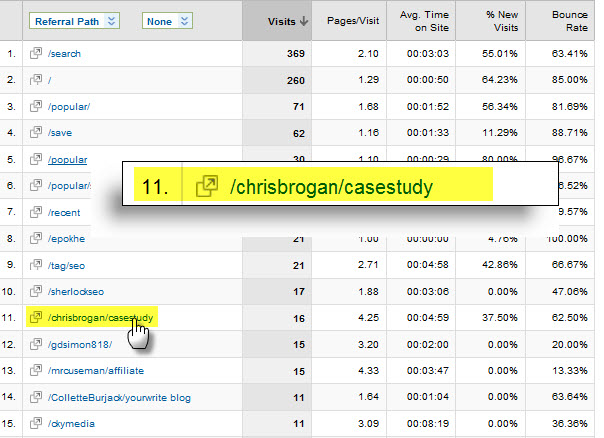
This is a list of referrers from delicious.com. Let's see what Chris Brogan, an influencer in the Social Media space bookmarked.
.jpg)
Aha! Makes perfect sense, he bookmarked the Facebook Marketing Guide. It didn't send a TON of traffic, but just think of the possibilites if we actually contacted him and worked together with Chris.
These are people who are individually sending traffic to your page, you probably should think about how you can use that information. As the Community Manager for SEOmoz I know that I will use it to reach out to them. Perhaps retweet them or ask them to write a YOUmoz post. Every organization is different, and this is just one idea. But take the concept of finding the users sending you traffic and run with it!
2. Don’t forget about mobile
My good friend Cindy Krum would probably strangle me for having forgotten all about mobile. This was another area Marty mentioned and I bet many people don’t focus on it. As an example, I thought I’d jump into our analytics and see how mobile users converted.
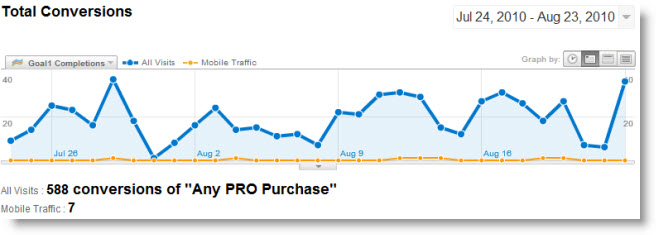
Yikes!! Before the recent update to our PRO landing page, we had just one PRO signup from a mobile device. That’s seriously pathetic. In the last month, we’ve had 7, which I’d imagine means that the changes we made, help mobile users sign up on our site. But it’s still ridiculously low!
I also thought about looking at what visits to the tools page looked like from mobile and non-mobile browsers. Ouch! This is our highest traffic page behind the home page. The iPhone, iPad and Android were the top 3 mobile devices (not surprisingly really). Perhaps we should make it a bit easier for these devices to access our site and tools. :)
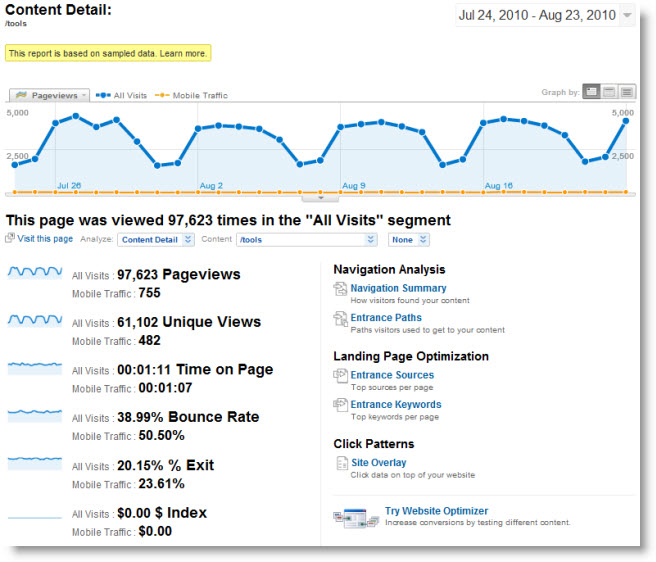
That's 482 uniques out of 61,102. Definitely something to work on.
3. “UGC is content that rocks”
That is an exact quote from Michael DeHaven, the SEO Product Manager at Bazaarvoice. Here at SEOmoz we most definitely understand the power of UGC for SEO (waves over at YOUmoz… hi!). But how can you use user generated content to help boost your traffic? Michael gave examples of how UGC helped several companies to increase traffic by adding unique, relavant, keyword rich content.
Check out this particular example for Swanson Health Products. The first image shows the product content. Sure it does have some unique content and some of the keywords they’re going for but in general the content is fairly weak.
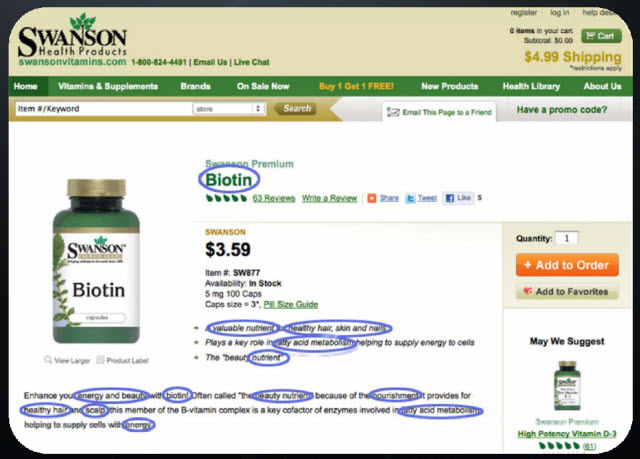
In the next image, you see all the great keywords that reviewers of the products have added all on their own. These aren’t SEOs creating content, but real people saying what they feel about the product. Hello! What a great way to increase content to your product pages.
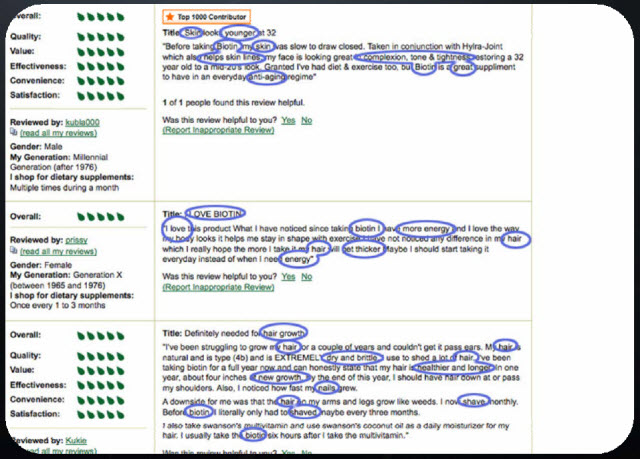
Another example he gave was for Opentable. Their initial implementation had the UGC uncrawlable. After they made a change and opened it up to search engines and were indexed, they had a 17% lift in traffic. Just by allowing the ratings to be indexed. Whoa!
The last example that stuck out in my mind that he gave was that QVC started sending emails to people after they purchased a product asking for a review of the product. It seems like common sense to do something like this, but at the same time it’s absolute genius. I bet you can think of at least one way to get visitors to your site to add content. Whether that’s in a review, a comment, a suggestion, whatever! Ask them a question; people love to give their opinions. :)
The point is… as Michael said it best “UGC is content that rocks,” so don’t forget about it!
4. Put “Hot Triggers” in the path of motivated people
This was the focus of the keynote by BJ Fogg the Director of Persuasive Technology Lab at Stanford University on the second day. Now, what does that mean exactly? The idea (and I hope I get this right) to make it easy for people who are ready to do something, to do it.
For example, one reason that Twitter did so well in the beginning is that they allowed people to use text message, to send tweets. Obviously they still do, but now many people use various mobile apps when they’re on their phone. When Twitter first took off though, people were used to reading short messages with a certain cutoff length, so tweeting was simple via text. People who were motivated to tell the world what they ate for breakfast, had the ability to do it quickly and easily.
There are several ways we could employ this here on the SEOmoz site, and one way I thought we could do this is to make it easier to sign up for PRO when you want to use a PRO only tool. Check out the example below for our Keyword Difficulty tool.
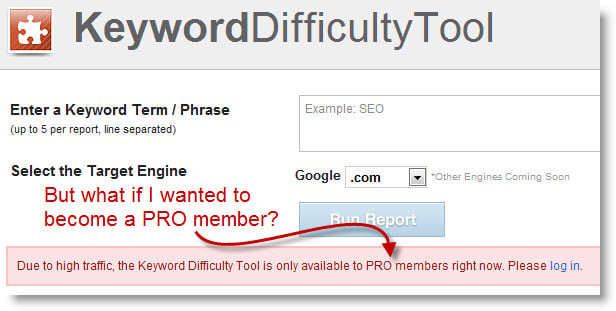
Sure, you can click on "log in" and from that page you can sign up and create a free account, but there's no way other than the "Go PRO" link at the top of the navigation to take someone to become a PRO member. If someone found their way to the Keyword Difficulty tool and is ready to use it, let's motivate them to become a member. Or at the very least, check out a free version.
Ok, honestly we know this happens on our site, and we're currently in the works of improving a lot of it (plus watch for a wicked awesome new site design next week!). But think about your site, and what you want people to do on your site. Are you hindering them in any way, or are you making it easy for them or difficult? BJ also discussed the idea that the "lightest touch works." Often times the motivation exists on the users side, but they just need to be facilitated through the action. Where can you make improvements on your site?
5. Public Relations, the other PR
Also on the second day, I attended a great session “Search, PR and the Social Butterfly.” I loved that Lisa Buyer focused on ways to attract journalists to your information. She mentioned that 100% of journalists use Google as a tool when working on stories. Think about it. Your PR strategies (and we’re not talking the PageRank ones now) need to be online where the journalists are looking. So if they’re searching, you want to be there!
She talked about today’s PR being a mix of being optimized, publicized and socialized. That means making sure you've optimized your content for not only your customers but for the media as well. Make sure you’re using keywords, relevant titles and don’t forget to add social links to your press releases. Lisa had a few great tips I wanted to share on publicizing and socializing to get the information out there. Don’t just sit around waiting for it to come to you. Here are just a few ways to get your content out there:
- Use a social media newsroom like PRESSfeed
- Find journalists on muckrack.com (a place to find journalists who are on Twitter)
- Subscribe to HARO (help a reporter out) and submit pitches directly to journalists
- Post your Press Releases to PRWeb and watch it get distributed (this is a paid service)
- Use Social Media to find journalists you want to reach out to
- Join #journchat Monday nights from 8-10pm EST on Twitter to chat with journalists, PR and bloggers
- Look at LinkedIn and Facebook
Brett Tabke from WebmasterWorld also spoke on this panel and talked about "the PubCon story." His story about how last year PubCon didn't spend a dime on marketing ads, and ONLY focused on twitter, made me absolutely giddy. I had heard rumors of this in the past, but to see the actual statistics was pretty cool. Oh, and not only did they not any money, they also saw an increase of 30% in attendance. What the... what?!
One of the things that jumped out at me the most was their use of Klout to find the influencers. This is somewhat similar to my first point above, but what they did was look up every person that registered for PubCon in Klout to see their influence and reach among Twitter. They then reached out to those with high Klout, like this guy, and thanked them for signing up, or retweeted them, etc. By contacting the people who can motivate and influence your followers (see how I just tied all my points together there?) while on their mobile phone (ok I'm stretching it), you end up gaining more reach.
This is actually something we try to do here at SEOmoz every day, how can you motivate your influencers?
Final Takeaways and Actions
- Don't forget analytics. Use the information to find influencers sending you traffic.
- What about mobile? Do you have users who would love to use your site on their mobile device but can't?
- UGC is content that rocks. How can you utilize UGC on your site?
- Put "Hot Triggers" in the path of motivated people.
- Public Relations is social now, so get on it.
This year SES had a ton to offer and I highly recommend you check out some of the live blogging from the event. Check out the recap of Liveblogging for day 1, day 2 and day 3.
Speaking of conferences, we have just a few tickets left for the SEOmoz Seminar next week. Grab them before we're completely sold out!
The author's views are entirely their own (excluding the unlikely event of hypnosis) and may not always reflect the views of Moz.

![Convince Your Boss to Send You to MozCon 2025 [Plus Bonus Letter Template]](https://moz.rankious.com/_moz/images/blog/banners/eee4a4a8-d4aa-457e-80b1-0ffa186b88ff_2025-06-27-174747_coli.png?w=580&h=196&auto=compress%2Cformat&fit=crop&dm=1751046467&s=454333def17ba9d472d3d98b6786741e)

![How To Drive More Conversions With Fewer Clicks [MozCon 2025 Speaker Series]](https://moz.rankious.com/_moz/images/blog/banners/Mozcon2025_SpeakerBlogHeader_1180x400_RebeccaJackson_London.png?w=580&h=196&auto=compress%2Cformat&fit=crop&dm=1750097440&s=296c25041fd58804005c686dfd07b9d1)
Comments
Please keep your comments TAGFEE by following the community etiquette
Comments are closed. Got a burning question? Head to our Q&A section to start a new conversation.